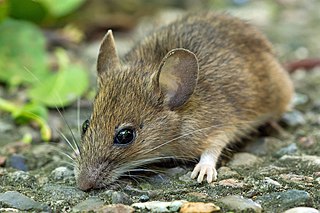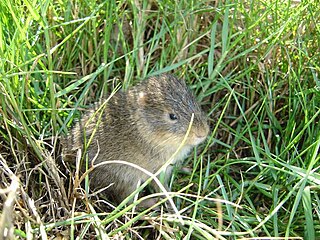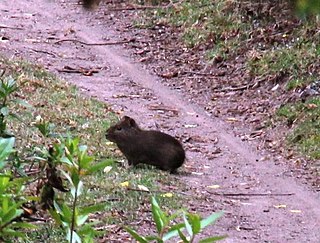
The guinea pig or domestic guinea pig, also known as the cavy or domestic cavy, is a species of rodent belonging to the genus Cavia in the family Caviidae. Breeders tend to use the word cavy to describe the animal, while in scientific and laboratory contexts, it is far more commonly referred to by the common name guinea pig. Despite their common name, guinea pigs are not native to Guinea, nor are they closely related biologically to pigs, and the origin of the name is still unclear. They originated in the Andes of South America. Studies based on biochemistry and hybridization suggest they are domesticated animals that do not exist naturally in the wild, descendants of a closely related cavy species such as C. tschudii. They were originally domesticated as livestock for a source of meat, and are still consumed in some parts of the world.

Caviidae, the cavy family, is composed of rodents native to South America and includes the domestic guinea pig, wild cavies, and the largest living rodent, the capybara. They are found across South America in open areas from moist savanna to thorn forests or scrub desert. This family of rodents has fewer members than most other rodent families, with 19 species in 6 genera in 3 subfamilies.

Dolichotis is a genus of the cavy family of rodents. These large relatives of guinea pigs are common in the Patagonian steppes of Argentina, but also live in Paraguay and elsewhere in South America. It contains a single extant species, the Patagonian mara, which is the one of the largest rodents in the world after the two species each of capybaras and beavers, and the large species of porcupines, reaching about 45 cm (18 in) in height.

The wood mouse is a murid rodent native to Europe and northwestern Africa. It is closely related to the yellow-necked mouse but differs in that it has no band of yellow fur around the neck, has slightly smaller ears, and is usually slightly smaller overall: around 90 mm (3.54 in) in length and 23 g in weight. It is found across most of Europe and is a very common and widespread species, is commensal with people and is sometimes considered a pest. Other common names are long-tailed field mouse, field mouse, common field mouse, and European wood mouse. This species is a known potential carrier of the Dobrava sequence of hantavirus which affects humans and may pose serious risks to human health.

Caviinae is a subfamily uniting all living members of the family Caviidae with the exception of the maras, capybaras, and Kerodon. The subfamily traditionally contained the guinea pig or cavy-like forms along with the cursorially adapted (running) Kerodon. Molecular results suggest the Caviinae as so defined would be paraphyletic and Kerodon is more closely related to maras and capybaras than to other caviines. This led Woods and Kilpatrick (2005) to unite Kerodon and capybaras into the subfamily Hydrochoerinae within the Caviidae. These studies also suggest Microcavia and Cavia are more closely related to one another than either is to Galea.

The genus Kerodon contains two species of South American rock cavies, related to capybaras and guinea pigs. They are found in semiarid regions of northeast Brazil known as the Caatinga. This area has a rocky terrain with large granite boulders that contain rifts and hollows where Kerodon species primarily live.

The Chacoan mara or Chacoan cavy is a relatively large South American rodent of the cavy family. They are a close relative of the better known Patagonian mara. The Chacoan mara is the sole member of the genus Pediolagus.

Cavia is a genus in the subfamily Caviinae that contains the rodents commonly known as guinea pigs or cavies. The best-known species in this genus is the domestic guinea pig, Cavia porcellus, a meat animal in South America and a common household pet outside of that continent.

Santa Catarina's guinea pig or Moleques do Sul cavy is a rare guinea pig species of southeastern South America.
The Brazilian yellow-toothed cavy is a cavy species from South America. It is found in Brazil.

Spix's yellow-toothed cavy is a rodent, a cavy species from South America. It is found in Bolivia east of the Andes and much of south central to northeastern Brazil. The species is found in open savanna and semiarid habitats, such as the Cerrado and Caatinga of Brazil. Its karyotype is 2n = 64 and FN = 118.

The montane guinea pig is a species of caviid rodent found in the Andes in South America. The montane guinea pig is the likely main ancestor of Cavia porcellus, the domestic guinea pig or domestic cavy, which appears to be a hybrid that includes lesser genetic contributions from other Cavia species.
Cavia anolaimae is a guinea pig species from South America. It is found in Colombia near Bogotá. It is believed to be a feral offshoot of the domestic guinea pig, Cavia porcellus, and is often treated as a synonym of C. porcellus, but Zúñiga et al. (2002), based on morphologic characters, recognized them as different species. According to the molecular analysis of Dunnum and Salazar (2010) C. anolaimae is a subspecies of Cavia aperea, C. aperea anolaimae, and a possible synonymous of C. a. guianae.

Cavia guianae is a guinea pig species from South America. It is found in southern Venezuela, Guyana, and portions of northern Brazil. Some biologists believe it to be a feral offshoot of the domestic guinea pig, Cavia porcellus; others subsume it under the wild cavy, Cavia aperea. Molecular data collected show there is little genetic differentiation in C.a. guianae known to be a lowland locality in comparison to C. anolaimae which are predominantly highland populations.
The common yellow-toothed cavy is a species of rodent in the family Caviidae, closely related to the domesticated guinea pig. It is found in Argentina, Bolivia, Chile, and Peru. Its karyotype has 2n = 68 and FN = 136. G. musteloides is the most common and widely found member of Galea, and is present at elevations ranging from 20 to 5000 m above sea level. It has yellow teeth.
The Andean mountain cavy is a species of rodent in the family Caviidae. It is found in Bolivia, Chile and Peru.

The plains viscacha rat, plains vizcacha rat, red viscacha rat, or red vizcacha rat is a species of rodent in the family Octodontidae native to Argentina. It is one of three species in the genus Tympanoctomys.

The Muenster yellow-toothed cavy is a species of rodent in the family Caviidae. It is known only from one location in Valle Hermoso in the Bolivian Andes, at an elevation of 2557 m. Specimens from this location were shipped to Muenster, Germany in 1997 for laboratory research, where the species was recognized and described. Galea monasteriensis was recognized on the basis of morphological, behavioral, and reproductive differences from related species. However, its habits in the wild have not been studied.

Galea leucoblephara, commonly known as the lowland yellow-toothed cavy, is a species of rodent in the family Caviidae. It is native to southern South America, specifically Argentina, Bolivia and Paraguay. The species was once considered part of Galea musteloides but is now a separate species.















